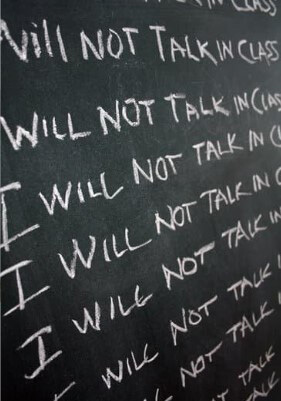Most of us tend to (or at least begin to) teach in more or less the same way we were taught. And here’s the thing – we aren’t even aware of it; we don’t realise that certain practices get passed down year after year… methods and practices that we consider ‘normal’ and perpetuate them without considering that they may be redundant in the current times, and that there may actually be better alternatives!
Vacation time is the best time to stop in our tracks and question the relevance of these methods – here I discuss 5 such TLMs which, frankly, I myself had used, but then decided to avoid / use very sparingly. I don’t think one can choose ALL or NOTHING when it comes to teaching! There are better strategies that will help us to meet the learning outcomes faster and more effectively, and it is time to revisit our typical old habits in TLM (usually boring for students).
1. Round / Random Robin Reading (a.k.a. Popcorn reading)
Technique: A teacher typically asks each student (the Robin) to take turn in reading aloud a short portion of a story, a chapter from a TB. Typically, all the students would need to remain alert since the next Robin selected could be any random student chosen by the teacher. Like randomly popping corns!
Why I used it: While I didn’t use it in SS, I did use it in the Language Arts, since (a) it consumed class time and the lesson (b) the story / concept kind of unfolded (c) we were able to explore new unfamiliar terms (d) the suspense of turns kept everybody quiet, and (e) I was able to silently tick of some formative assessment parameter for RC fluency.

Research indicates: This is NOT a good strategy because it simply does nothing to actually improve student comprehension or reading skills. Also, it embarrasses students whose read-aloud skills are not at par. It offers only a tiny window of time for each student to actively read, and listening to their classmates read at varying levels of skill, this technique can actually teach students to read more poorly as they pick up the habits of their peers. Also, there is no guarantee that the ones not reading are actually concentrating!
Alternatives you could try: Depending on the age-group you are teaching, you may like to explore numerous alternative strategies by accessing this link: https://www.edutopia.org/blog/alternatives-to-round-robin-reading-todd-finley
2. Readymade Notes
Technique: This is when a teacher supplements an oral lecture with a handout that contains pre-written notes on that content, usually notes-pages that can be generated automatically from a PowerPoint presentation, or drafted from research on the internet and other similar publications.
Why I used it: I have used it in SS more than in Language Arts – typically to add breadth and depth of knowledge (since I was almost always dissatisfied with quantum of content exposure in the chosen TB publication). I felt that by giving ready-made notes (called Additional Factsheets), I was making it easy for students who had missed class to catch up, and it also prevented students from missing important points made during the lecture.
Research indicates: This, in fact, was a gross disservice to students! I was just making things easy for them! Literally, catching the fish and feeding it to them, rather than teaching them how to fish! I soon realised, when no effort is required in the learning process, learning doesn’t last very long.

Alternatives you could try: You may like to switch to teaching your students the skills of note-taking, not just for your lectures, but also the skills of summarising key take-aways from reference books, internet sites and suggested video films. Sure, it may take time; but in the end, you will see it was worth it!
There are many ‘note-taking’ techniques – have your students try a few and decide what’s right for each of them. Allow students to compare notes with each other, discuss them, and revise them. Another powerful way to support students in their note-taking is to provide them with pre-lecture diagrams, visual structures like mind-maps that help them to understand the relationship between the concepts you’re about to teach. To learn more about such alternative note-taking techniques that work wonders, please access: https://collegeinfogeek.com/how-to-take-notes-in-college/
3. Teacher-favoured Punishments!
-
Whole Class Punishment

Technique: The teacher punishes the whole class for some behaviour infraction committed by only one / some students. Often, this takes the form of a lost privilege, like recess or a games period or a cancelled field trip or even writing something 100 times!
Why I used it: I have to say here, that I have used this in the past, especially when a bunch or half the class would fool around or get too noisy! While I can now appreciate the redundancy of it all, I provide feeble justification which may be the same rationale provided by teachers practicing this today….well, it was faster and easier than trying to figure out exactly who caused the disruptions (I knew it wasn’t everyone, but who was counting?!) I issued the threat in the hope that I wouldn’t have to enforce it. I wanted to motivate them, to get them to behave in order to earn some reward. When it didn’t work and I had to use the verbal-emotional whip, I hoped the memory of the loss of a privileged activity would get them in order.
Research indicates: In the absence of any research on this practice, I read up on some pretty strong public opinion that completely vetoed this TLM practice. Some said that whole-class punishment was and is “fairly ineffective at best, and strongly counterproductive at worst, in shaping group behaviour.” Many teachers recounted that they had been that kid who tried to behave, but got punished along with the entire class. Some shared that their own offspring today had been put in that position. And of course, there would also be those among us who were the ones that caused the trouble, leading to mass punishment! In essence, the weight of “ruining it for everyone” certainly cannot lead to effective classroom learning, nor foster healthy relationships with one’s peers, nor earn brownie points with the teacher or school authorities.
Alternatives you could try: The best way to deal with a rowdy class is preventive medicine! If on many of your days, your whole class feels chaotic, this is actually symptomatic of a larger problem. Perhaps your directions aren’t clear; or your students seem disinterested, bored. You may need to explore more engaging strategies for interaction and movement into your lessons. If your teacher kitty is exhausted and the concern appears to stem from the student body, then it could be time to re-assign ground rules and agree upon clear behaviour-guidelines and consequences. When small disruptions come up, it’s best to deal with them quickly before they grow into bigger problems.
Do check out the Distract the Distractor strategy here: https://www.cultofpedagogy.com/distract-the-distractor/ OR
the Notebook Strategy here: https://www.cultofpedagogy.com/notebooks-part-1/You may also like to look up these sides for some alternative Classroom Management techniques:
(i) https://smartclassroommanagement.com/2011/10/15/how-to-handle-whole-class-misbehavior/
(ii) https://www.edutopia.org/blog/positive-not-punitive-part-1-larry-ferlazzo -
Stand outside / Go out of the class
Technique: If a child continues to disrupt the class and/or misbehaves, s/he is sent out of the class to singularly adorn the corridor, or is sent to some other person!

Why it was/is used: I have to admit that I have never used this technique at all, since I have always believed that an idle mind in the corridor could result in a worse devil’s workshop! I did, have errant students dotting the isolated far corners within my class – believing that at least, if the child was standing there facing me (without eye contact with the peers), s/he would be forced to listen and some of the ambient learning would seep into the disruptive brain! Some teachers, even today, choose to send off disruptive kids to a colleague’s class or to the staff room or worse still, to the ‘Principal’s room’!
The claim: the time-out helped the student and themselves to realign to what needed to come next and get done.
Research indicates: If a child’s behaviour isn’t good enough in one class it probably is the same in other classes too. If s/he is sent to another place, s/he may go on to misbehave there too or be motivated to behave out of fear rather than accountability and reformation. Imagine – one kid has potentially disrupted 40-60 children’s learning in one period! Also, why burden another teacher or the Principal for one’s own failings in classroom management? Everyone needs free time for their level of planning and preparation, not for looking after misbehaving students.
Alternatives you could try: In most child-centric schools where students misbehave, they prefer students to be sent to a specific room (isolation/withdrawal etc) where one person looks after these students, rather than the possibility of causing more issues for other students, other staff and waste learning time. It is then for the teacher and HOD to attempt to resolve/organise a consequence-meet with the student at another time.
Unless the misbehaviour is repeated despite warnings, or harmful to the general peace, quiet and safety of the school – it is better to not involve the parents nor advisable to send complaint notes to parents in the diary. Would you, as a teacher, like to receive similar notes from parents regarding how the child misbehaved in the home scenario? The recourse for reformative & positive action must be initiated and addressed at the location of misbehaviour.
4. Using Learning Styles to Plan Instruction
Technique: Most B Eds and similar degrees teach budding teachers the concept of MI and how every learner is either a visual, auditory, or a kinaesthetic learner. Other learning styles also exist, each one offering labels to define how students process information. Consequently, some teachers end up differentiating instruction by separating students into groups based on these tendencies. Once a student has been labelled with one particular learning style, the teacher attempts to adjust her teaching style to reach students through their identified learning mode.
Why I used it: This one I didn’t really use too much. I was aware of learning styles and I was always mindful of the need to present information in different ways to the entire group, with some extra guidance for some. E.g. for a student who had a lot of trouble following spoken instructions, I always tried to include written instructions. For a visual learner, I allowed drawing-based answers instead of dry para-text. Although, I never really felt I had aced competency in the realm of differentiated instruction.

Research indicates: Attempts to find evidence / correlation that ‘matching the teaching style to the students’ learning style led to greater learning gains’, yielded nothing! I looked at study after study, but found NO proof that this practice has any impact at all. In fact, there is evidence to suggest that kids learn better through different modalities AND attempting to label students and narrow our teaching strategies with them can ultimately limit them, making them believe they are only capable of learning in one way.
In the context of Multiple Intelligences, Howard Gardner says, “It’s very important that a teacher takes individual differences among kids very seriously. The bottom line is a deep interest in children and how their minds are different from one another, and in helping them use their minds well.”
Alternatives you could try: Provide a variety of learning experiences and plan your instruction to reach all students through different pathways. In the same way that eating a variety of foods helps ensure you get all the nutrients you need, using a variety of instructional strategies will help you to reach every student. You may like to explore some strategies through these links:
For Text Structures: https://www.cultofpedagogy.com/text-structures/
For Cultural Diversity: https://www.cultofpedagogy.com/culturally-responsive-teaching-strategies/
Mind’s Eye Technique: https://www.cultofpedagogy.com/minds-eye/
Concept Attainment Model: Concept Attainment Model: https://www.cultofpedagogy.com/concept-attainment/
5. PEER Tutoring the old-fashioned way
Technique: The teacher plans a lesson aimed at the ‘average / middle group’ of learners. Thereafter, in order to provide extra assistance to students who need it, and simultaneously provide extra challenge for students who grasp the concepts quickly, the teacher plans to have the smart students (who finish the assigned task early), help those lagging behind.

Why I used it: Oh yes, this one I did use; it just made so much sense! I couldn’t be everywhere to help all the students who needed it, and my more advanced kids were just sitting around with nothing to do (warning bell!), so it seemed like the best-fit solution. The kids who needed help got it, and the advanced kids got to learn the material really well by teaching it to someone else (remember the familiar quote – Teaching is Learning Twice?). Easy-peasy – two birds killed with one stone. As for Differentiation, hmmm?
Research indicates: No. That’s not differentiation. Although mixed-ability groups and tutoring can benefit the students who need help to some degree, these arrangements do very little for the advanced students in pushing their limits, or in engaging them in higher order thinking. In order to receive the appropriate challenge, high-ability or gifted students need regular opportunities to be grouped with like-ability peers. Having advanced students do peer tutoring of less capable kids doesn’t necessarily do them any harm, but if overused, it compromises true differentiated instruction. Neither does it offer learning experiences that would challenge these students at an appropriate level.
Alternatives you could try: Peer tutoring can be used, but very occasionally, thereby allowing students to share their unique gifts with their peers. To address the needs of all learners, we strongly recommend that you try the strategies recommended by Carol Ann Tomlinson in her book, The Differentiated Classroom, including learning stations, tiered assignments, orbital studies (3-6-week independent investigations), and learning agendas, where students are given a list of tasks to complete in whatever order they want over a period of several weeks, much like the kind of personalized plans given to students every day in Montessori classrooms. If you have a class with ‘gifted’ learners, you may like to access the strategies mentioned in: https://nagc.org/
Finally, after spring cleaning these old habits, here’s something fresh you may like to add to your basket of goodies as you approach the new academic session : 6 Powerful Learning Strategies that you must teach your kids – https://www.cultofpedagogy.com/learning-strategies/
As rightly stated by Dylan Wiliam – “A bad curriculum well taught is invariably a better experience for students than a good curriculum badly taught: pedagogy trumps curriculum. Or more precisely, pedagogy IS curriculum, because what matters is how things are taught, rather than what is taught.”
Good Luck!


